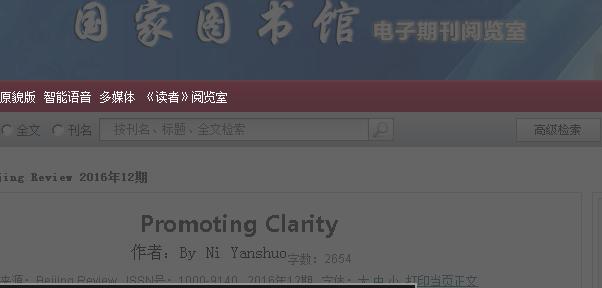Will Overcapacity Cuts Lead to Massive Layoffs?
2016-03-28

At a press conference on the sidelines of the annual full session of the National Peoples Congress, Chinas top legislature, in early March, Xu Shaoshi, Minister of the National Development and Reform Commission, predicted a positive outlook for this years employment figures. He believes that efforts to cut excessive industrial capacity will not incur massive layoffs like that of the late 1990s when a large number of poor-performing state-owned enterprises (SOEs) axed tens of millions of jobs through bankruptcies and reorganization.
Overcapacity in the steel and coal sectors has recently received significant attention against the backdrop of a slowdown of Chinas economic growth. Falling prices of relevant products have placed most companies in the two sectors, most of whom are large SOEs, in difficult conditions. In the process to reduce their excess capacity, about 1.8 million workers will have to be laid off or relocated, according to official estimates.
Helping workers made redundant regain their footing while at the same time offering jobs to the 15 million new additions to the national labor force in 2016 poses an enormous challenge to the Chinese Government. While the Central Government has pledged 100 billion yuan ($15.4 billion) to help laid-off workers reestablish themselves, local governments also claim that they are completely capable of coping with this task.
The governments promises have helped to calm the nerves of some people who believe that the social and labor environment today is quite different from what it was in the late 1990s, so several million job losses wont hamstring the economy as a whole. However, others argue that this is not a small number, and if not properly dealt with, the whole societys stability might be severely affected.
Li Huadong (Peoples Daily): Addressing excess industrial capacity is a necessity for the optimization of Chinas industrial structure and the sustainability of sound economic growth. Although this will inevitably lead to a large num- ber of laid-off workers, this time will be different from what happened in the late 1990s.
Faced with sharply shrinking profit margins, it is urgent to reduce overcapacity in industries plagued by the problem, especially the steel and coal sectors. This is in line with the market rule. We dont need to be overly pessimistic.
The government has pledged to provide 100 billion yuan to help workers who lose their jobs in the process of overcapacity cuts, and together with social security benefits, various favorable policies for business startups, new jobs created by enterprises restructuring and also a broad reemployment market, it is not too thorny of a task to help the unemployed get reemployed.
Nowadays, Chinas labor market is still short of sufficient laborers, which promises many job opportunities for laid-off workers. With the development of Internet-based businesses, there is a bright prospect for reemployment, particularly because most redundant workers from SOEs are equipped with relatively high professional skills.
Ouyang Mijian (21st Century Business Herald): In the late 1990s, a large-scale reform of SOEs and a slowdown of economic growth led to massive layoffs, with tens of millions of workers being let go. Surging unemployment dealt a strong blow to the economy and overall Chinese society, while the laid-off individualsdaily lives and even psychological health were severely affected. At that time, the pressure of helping these people get reemployed was an unbearable burden on the shoulders of government at various levels.
More than two decades have passed, but the memory is still fresh. Therefore, when China is again faced with economic growth slowdown and the necessity to cut overcapacity in some industries, the concern of possible massive layoffs rises again.
However, the situation nowadays is less severe than at that time. Instead of tens of millions of workers to be laid off, today, the number is not as big.
Still, we must be cautious about the pos-sible risks. The Central Government has stressed that during the process, mergers and acquisitions are preferred to bankruptcies and closures of overcapacity-plagued companies, so as to reduce the number of laid-off workers.
Most of those who are laid off due to the cutting of excess industrial capacity need to find a new job, with some of them choosing to start up their own business or turning to the service sector. But these are not solutions for the majority of those who will be affected. Thus, the restructuring must be accompanied by industrial upgrading, to reduce negative impacts on the economy and employment.
Lin Boqiang (Global Times): Overcapacity will lead to a sharp slide in commodity prices, which in turn will result in a drop of production and finally a deteriorating financial situation for struggling companies. If by cutting the excess capacity, both the macroeconomic situation and companies fiscal situation can improve, it is necessary to lay off workers from unneeded posts. These workers can manage to find new jobs after receiving training in new skills.
Zhu Haibin (Finance.sina.com.cn): Worries about the forthcoming massive layoffs are overstated. The situation is far better than in the late 1990s, when tens of millions of workers were laid off over just a few years. Besides, at that time, workers laid off from SOEs had almost no opportunities for reemployment, mostly because cheap labor forces from rural areas kept swarming into the cities for jobs. However, Chinas working-age population started falling in 2011, which means some sectors are experiencing a labor shortage. The government may also encourage reemployment by increasing financial inputs in skill training for laid-off workers.
Huang Zhizi (Rednet.cn): The cutting of unneeded capacity in the steel sector might result in the sacking of about 500,000 workers. Added together with the large-scale layoffs in the coal and manufacturing sectors due to upgrading and restructuring, this issue must be appropriately addressed.
Most of the workers in the coal, steel and manufacturing industries are middle-aged. They devoted their youth and energy to the work they have been doing so for decades and have made great contributions to Chinas industrialization and rapid economic growth. Today, the restructuring and upgrading of their enterprises will force them away from their posts, and theyll have to look for a new job at an awkward age. It is a real challenge for their future life.
There must be training programs targeting reemployment for these workers, together with favorable financial support from the government and banks for them to start up their own business, effective reemployment guidance, etc.
Lan Hengmin (Economic Herald): Generally speaking, local governments do not want firms to simply dismiss workers in the process of getting rid of excess capacity, but they hope the enterprises will try to keep the workers, even if in a different position. In the past several years, as long as an unprofitable company is not shut down, some redundant workers at certain posts may be relocated to other posts within the same company, to prevent job loss.
However, with industrial advancement, the feasibility for workers laid off to move from one assembly line to another will decline. Meanwhile, some companies are bound to be totally closed down. Those who are capable of finding a proper job tend to leave frail employers long before they are forced to go, while those who stay tend to be less competitive in finding a good employer.
The government is responsible for protecting the legitimate rights of workers faced with the fate of being laid off, such as economic compensation and social security benefits. These workers should also be encouraged to find jobs in emerging sectors, such as elderly care, domestic service, working as a mail courier, etc. These industries are now short of sufficient employees, and at the same time, they are growing fast and offer promising career prospects.
